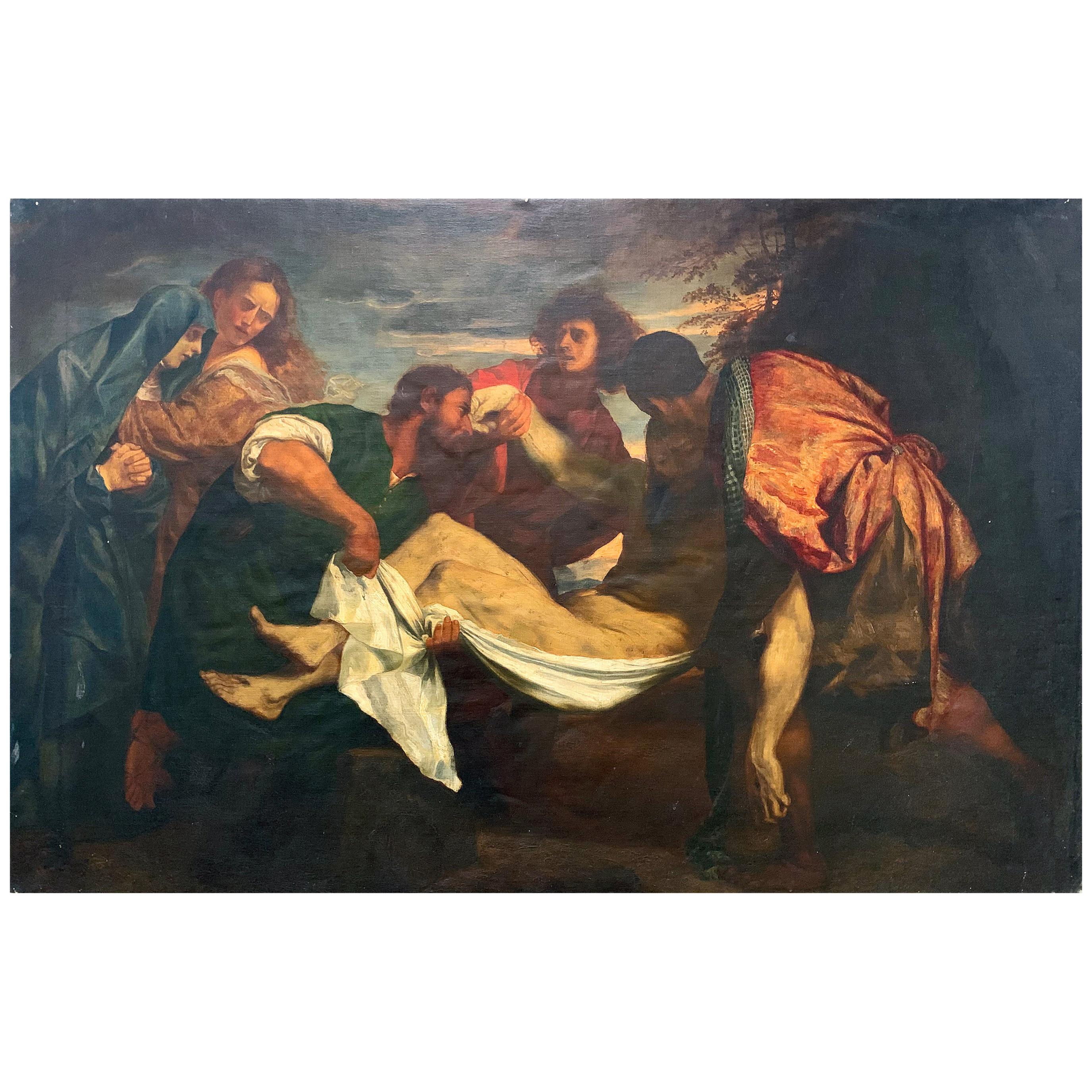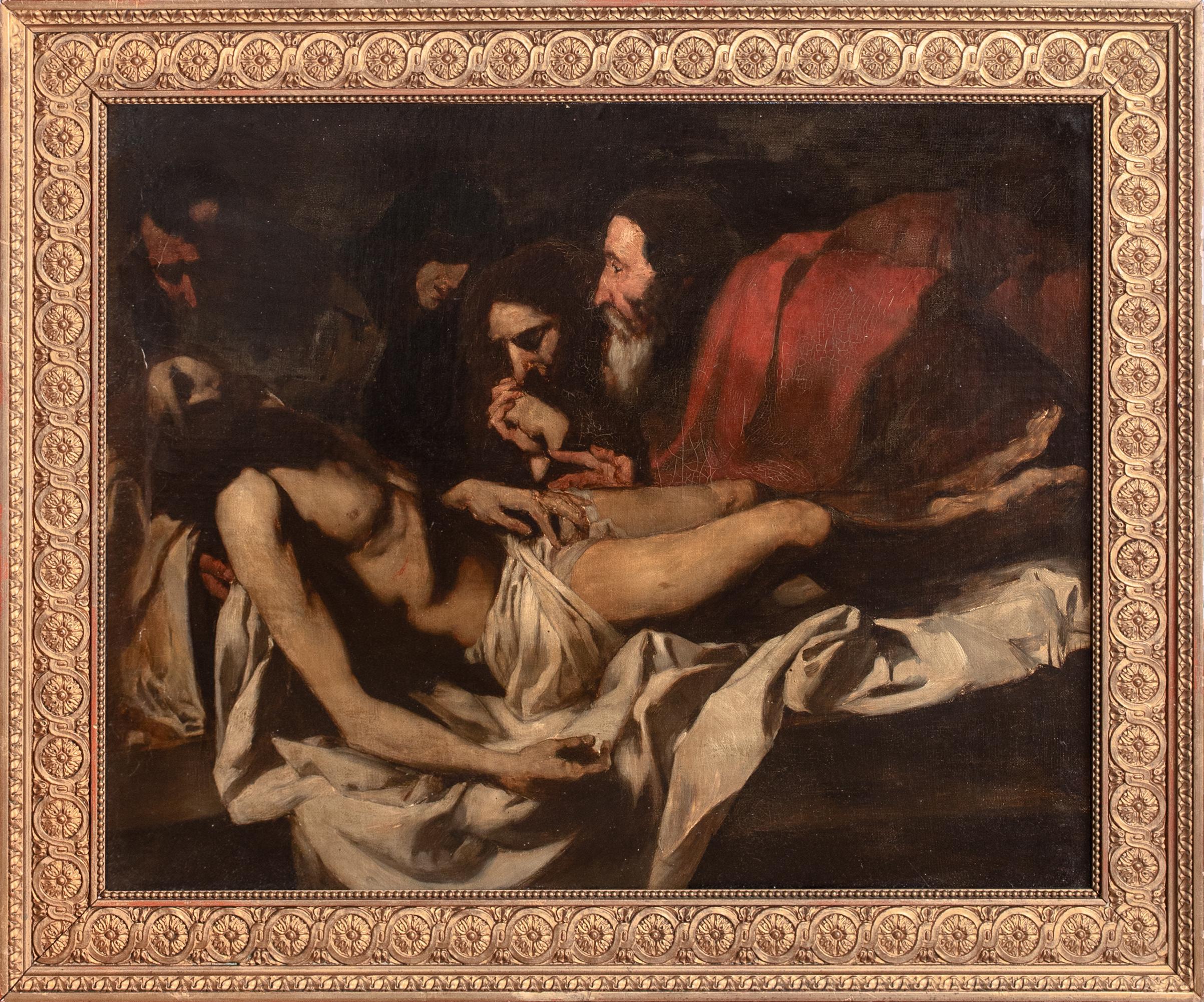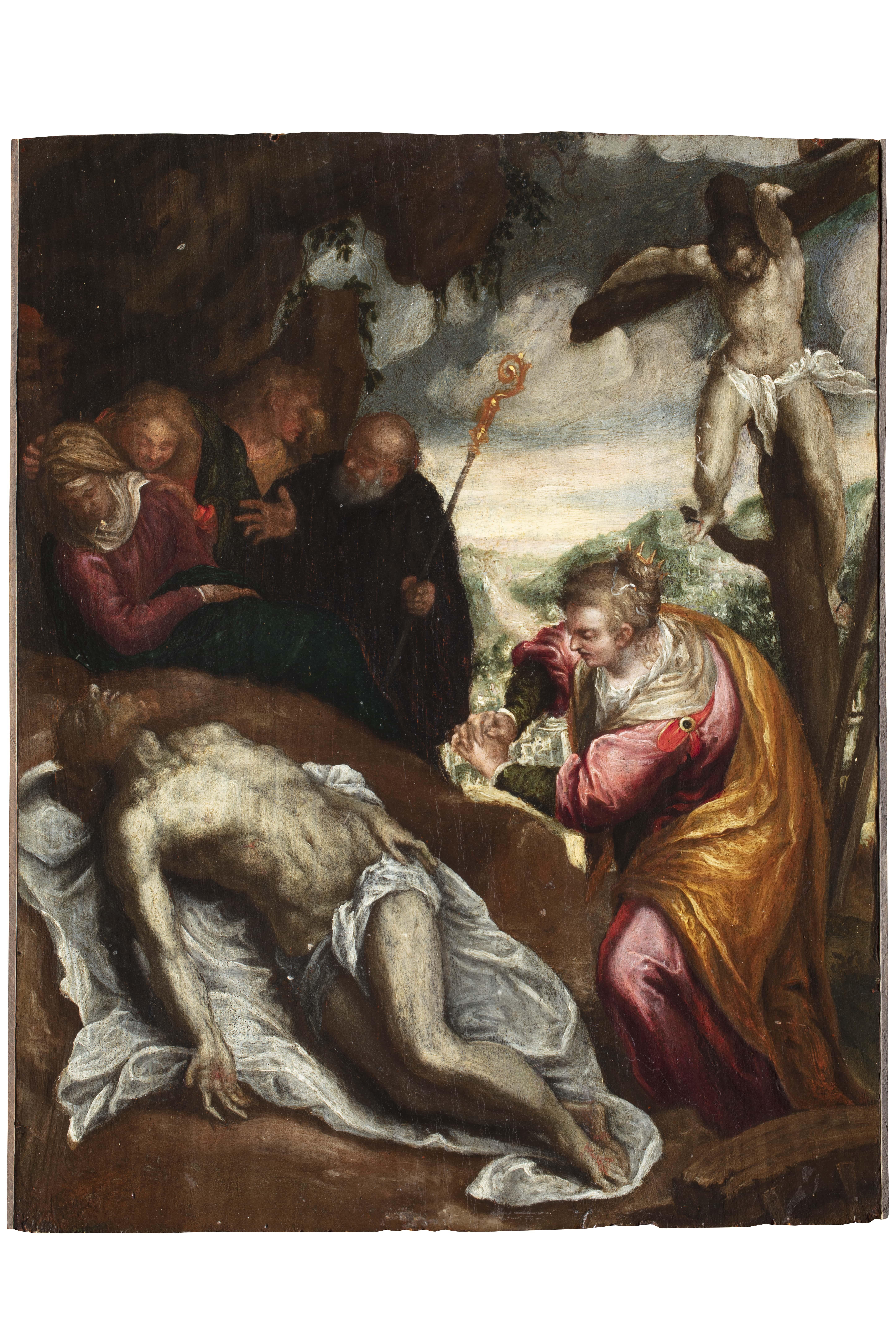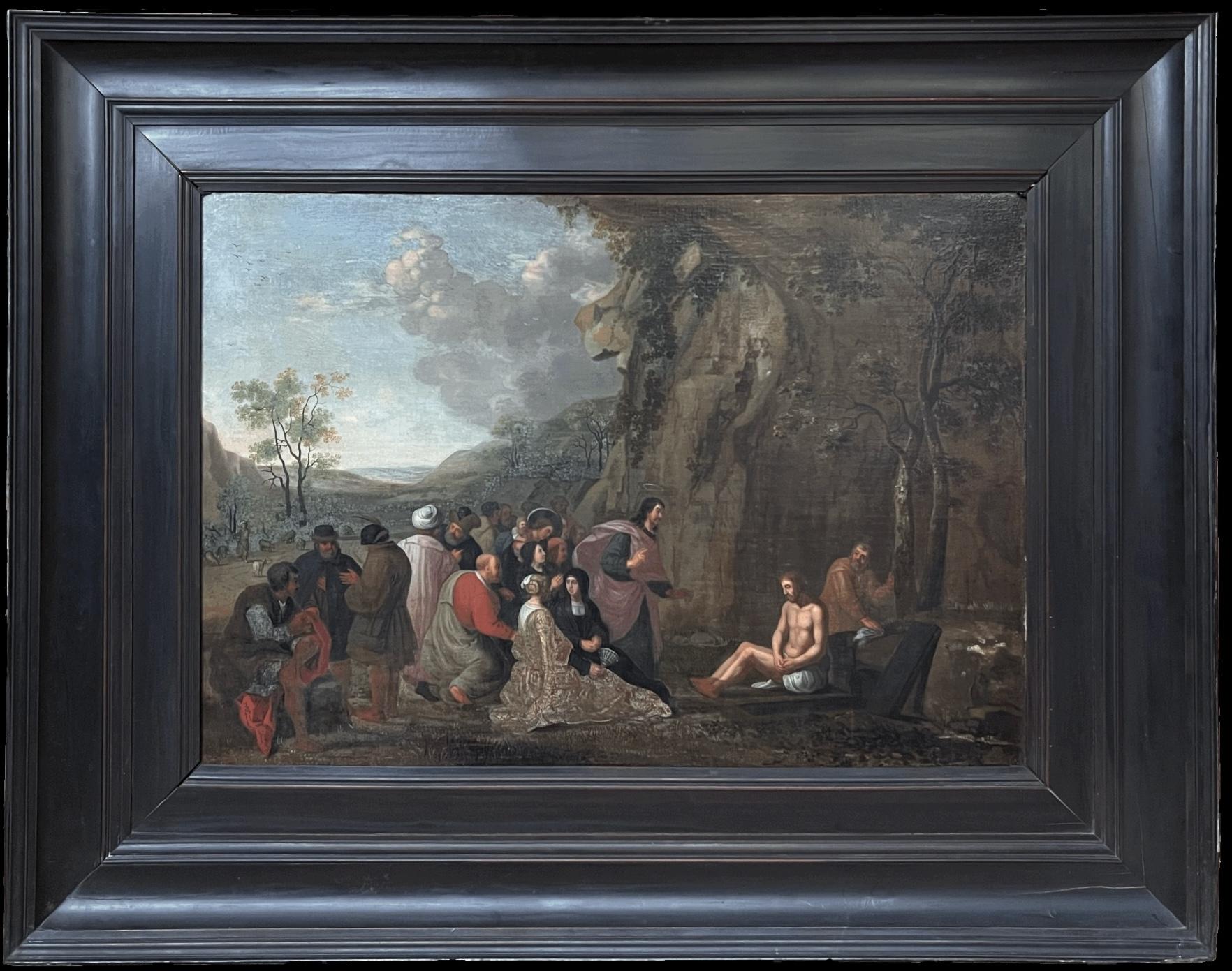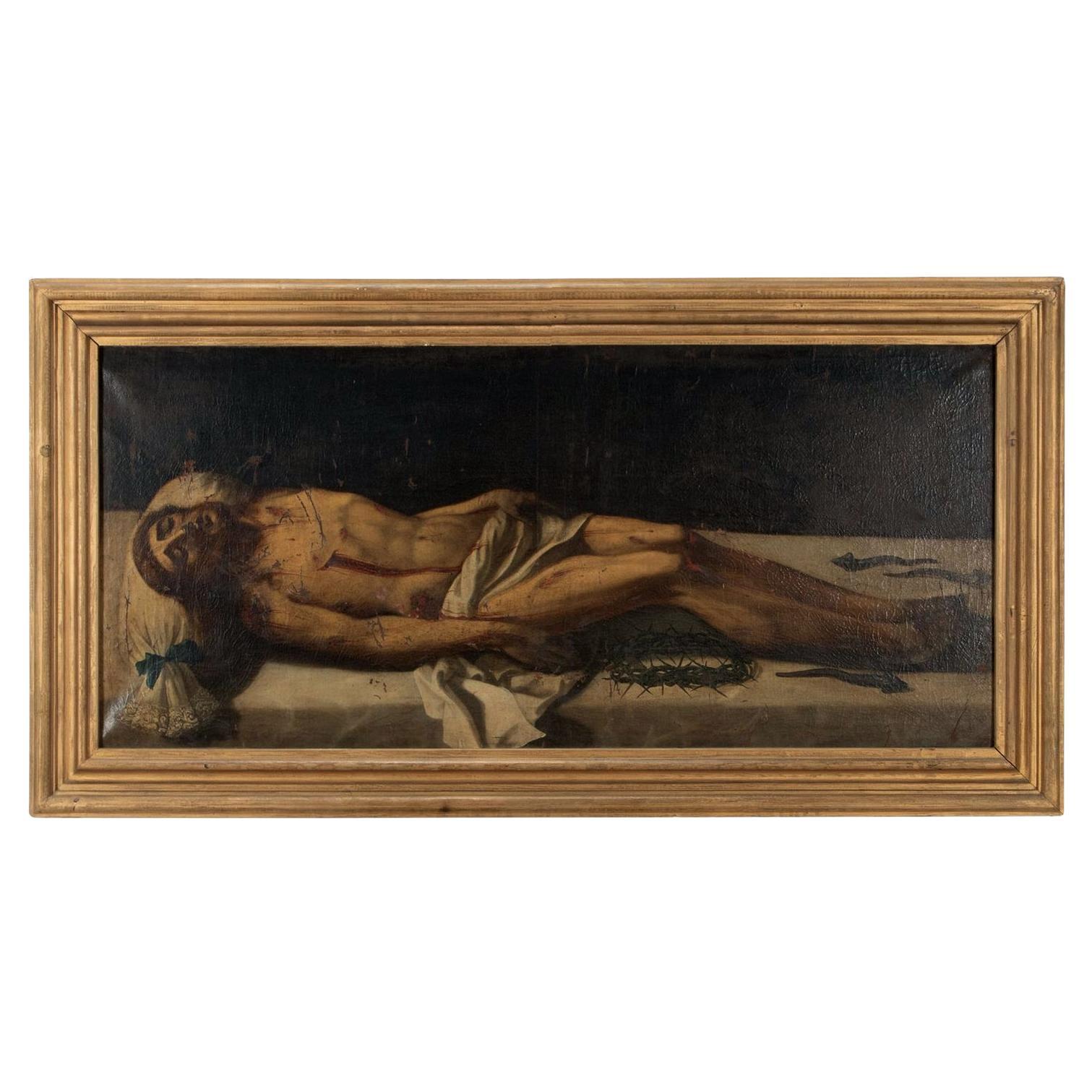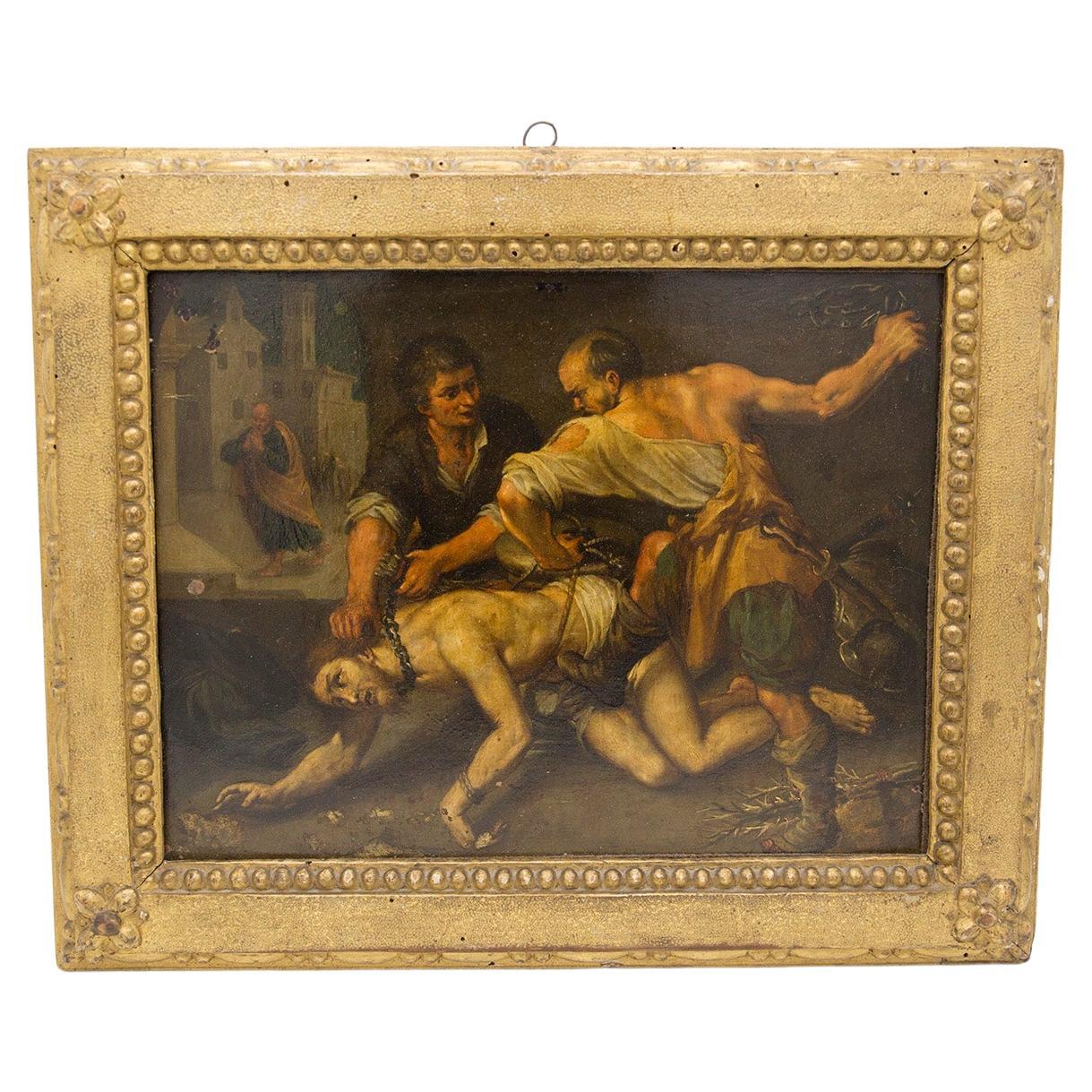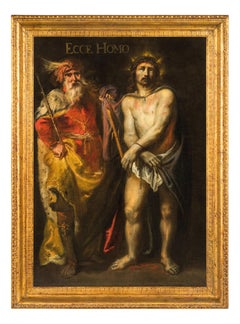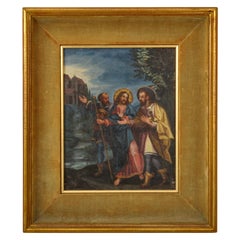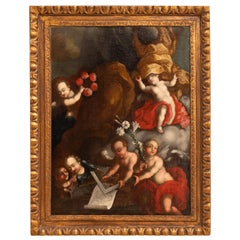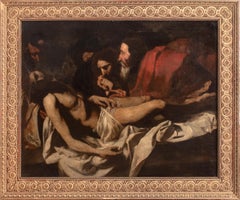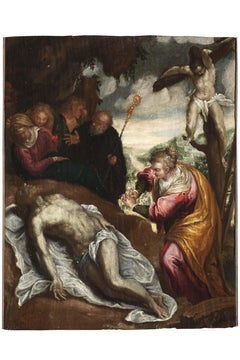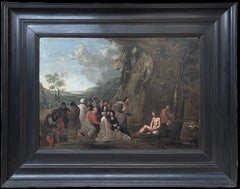Items Similar to Italian Early 17th Century Renaissance Baroque Oil Painting Entombment of Christ
Want more images or videos?
Request additional images or videos from the seller
1 of 17
Italian Early 17th Century Renaissance Baroque Oil Painting Entombment of Christcirca 1620
circa 1620
$7,800
£5,922.72
€6,773.08
CA$10,897.73
A$12,120.66
CHF 6,329.03
MX$147,495.49
NOK 80,831.37
SEK 75,805.56
DKK 50,550.08
Shipping
Retrieving quote...The 1stDibs Promise:
Authenticity Guarantee,
Money-Back Guarantee,
24-Hour Cancellation
About the Item
An important & large Italian Baroque period oil painting on panel attributed to Daniele Crespi (1598-1630), "The Entombment of Christ", Milan circa 1620. See artist biography below.
The painting depicts Christ having being removed from the crucifix and being prepared for entombment, the painting shows The Virgin Mary is being comforted by another figure and Nicodemus is shown pulling down the shroud as another male figure rests Christ's body on the shroud that he is about to be laid to rest in. The artist displaying a significant influence of Caravaggio.
The painting is on a substantial walnut panel and is housed in a 19th century black hardwood frame with a gilded liner, condition is very good, the painting has just been professionally cleaned and re-varnished by one of the West Coast's most skilled conservators, this exceptional painting is ready to hang on your wall.
Daniele Crespi (1598–1630) was an Italian Old Master painter & draftsman. He is regarded as one of the most original artists working in Milan in the 1620s. He broke away from the exaggerated manner of Lombard Mannerism in favor of an early Baroque style, distinguished by clarity of form and content. A prolific history painter, he was also known for his portraits and religious subjects.
He was born in a family that was originally from Busto Arsizio. It is not clear whether he himself was born in Busto Arsizio or in Milan. The date of his birth is not known with certainty with estimates ranging from 1591 to 1598. His training is not well documented and he is first recorded in 1619 as working with local painter Guglielmo Caccia working on an assignment in a church in Milan.
One of his first teachers was Giuseppe Vermiglio of Turin. He next studied with Giovanni Battista Crespi and Giulio Cesare Procaccini. In 1621, Crespi was involved with the Accademia Ambrosiana, Crespi died in Milan during the plague epidemic in 1630.
Among his pupils was Melchiorre Giraldini, Crespi was mainly active as painter of religious subjects used as decoration for churches. He was also known for his sensitive portraits. He was an excellent colorist, known for the simplistic beauty of his compositions. His best works include a series of pictures from the life of Saint Bruno (now in the Certosa di Garegnano in Milan) and a depiction of the Stoning of St. Stephen (in Brera). Another masterpiece is the dark 1628 Supper of St Carlo Borromeo in the church of Santa Maria della Passione in Milan, one of the best-known early 17th-century paintings in northern Italy. Other works by him can be found in Milan and Pavia (Pavia Cathedral and Certosa di Pavia.
The Conversion of Saint Paul, painted about 1623, is considered to be the artist's finest painting in the United States (at the Blanton Museum of Art in Austin). When compared to Caravaggio's earlier work in the Cerasi Chapel, it shows the persistence of Crespi's Mannerist traits.
- Attributed to:Daniele Crespi (Busto Arsizio, 1597-1600 - Milan 1630) (1597 - 1630)
- Creation Year:circa 1620
- Dimensions:Height: 26.25 in (66.68 cm)Width: 52 in (132.08 cm)Depth: 2 in (5.08 cm)
- Medium:
- Movement & Style:
- Period:1620-1629
- Condition:very good condition, at sight/without frame 45" x 19".
- Gallery Location:Portland, OR
- Reference Number:Seller: BB-102681stDibs: LU1366214797042
About the Seller
5.0
Platinum Seller
Premium sellers with a 4.7+ rating and 24-hour response times
Established in 1990
1stDibs seller since 2020
57 sales on 1stDibs
Typical response time: 1 hour
- ShippingRetrieving quote...Shipping from: Portland, OR
- Return Policy
Authenticity Guarantee
In the unlikely event there’s an issue with an item’s authenticity, contact us within 1 year for a full refund. DetailsMoney-Back Guarantee
If your item is not as described, is damaged in transit, or does not arrive, contact us within 7 days for a full refund. Details24-Hour Cancellation
You have a 24-hour grace period in which to reconsider your purchase, with no questions asked.Vetted Professional Sellers
Our world-class sellers must adhere to strict standards for service and quality, maintaining the integrity of our listings.Price-Match Guarantee
If you find that a seller listed the same item for a lower price elsewhere, we’ll match it.Trusted Global Delivery
Our best-in-class carrier network provides specialized shipping options worldwide, including custom delivery.More From This Seller
View AllOld Master Flemish Oil on Canvas Baroque Painting Jesus Christ Ecce Homo 1630
Located in Portland, OR
An important Old Master oil on canvas painting by the Flemish artist, Jan Cossiers, a follower of the style of Caravaggio (1600-1671).
Born in Antwerp in 1600, Jan Cossiers was a pupil of his father, the painter Antoon Cossiers (died 1646/1647), and also studied under Cornelis de Vos...
Category
17th Century Baroque Figurative Paintings
Materials
Canvas, Oil
18th Century Italian Old Master Tempera on Panel Painting "Jesus Road to Emmaus"
Located in Portland, OR
An important 18th century Italian Old Master tempera on copper panel Baroque painting, "The Road to Emmaus", circa 1700.
The painting represents the early resurrection biblical story...
Category
Early 18th Century Baroque Figurative Paintings
Materials
Copper
Italian Renaissance Tempera on Parchment Painting Holy Family by Giuseppe Cesari
Located in Portland, OR
A rare & important Italian Renaissance tempera on parchment painting, Giuseppe Cesari Il Cavalier d'Arpino (Giuseppe Cesari, 1568-1640), the painting c...
Category
16th Century Renaissance Figurative Paintings
Materials
Parchment Paper, Egg Tempera
Austrian Old Master Baroque Oil Canvas Painting Architecture Allegory Cherubs
Located in Portland, OR
An important & large oil on canvas Baroque painting by the Bohemian Old Master artist, Franz Xaver Karl Palko (1724-1767), an allegory of architecture, circa 1750.
The painting depic...
Category
1750s Baroque Figurative Paintings
Materials
Canvas, Oil
Large Antique Italian Baroque 18th Century Still Life Fruit Oil Canvas Painting
Located in Portland, OR
An exceptional & large antique Italian baroque still life oil on canvas painting, attributed to Carlo Magini (1720-1804), a still life scene of a table setting with bowls of fruit, c...
Category
1780s Italian School Still-life Paintings
Materials
Oil, Canvas
Flemish Early 17th Century Old Master Oil on Panel Painting Hunting Scene 1620
Located in Portland, OR
A highly important Flemish Old Master oil painting by Peter Van Lint (1609-1690), titled "Preparing for the Hunt", the painting is dated & signed by the artist, 1620. The painting wa...
Category
1620s Old Masters Landscape Paintings
Materials
Oil, Panel
You May Also Like
"The Entombment of Christ, " Fine Copy of Titian Masterpiece, Oil on Canvas
Located in Philadelphia, PA
Beautifully painted, probably in the 19th or early 20th centuries, this copy of the famed "Le Transport du Christ au Tombeau" painting by Titian (Tiziano) in the collection of the Louvre in Paris, was recently found in the attic of a Hudson Valley monastery. The Louvre original, considered an early painting by the master, dates to the same period as his famous "Pastoral Concert" and shows the strong influence of Gorgione. This scene depicts the collaborative efforts of Joseph of Arimathea, Saint John and Nicodemus as they moved Christ's body from the cross to his tomb, watched by the two grieving Marys -- his mother and Mary Magdalene. It is not known who painted this copy, though of course artists over the years have copied the great Master paintings...
Category
Early 20th Century Italian Renaissance Paintings
Materials
Paint
The Lamentation Of Christ, 17th Century
Located in Blackwater, GB
The Lamentation Of Christ, 17th Century
follower of CARAVAGGIO (1571-1610)
17th century Italian Old Master depiction of the Lamentation Of Christ, oil on canvas laid to panel. Exce...
Category
17th Century Portrait Paintings
Materials
Canvas, Oil, Wood Panel
$3,562 Sale Price
35% Off
16th Century by Venetian Maestro Deposition of Christ Oil on Panel
Located in Milano, Lombardia
16th Century Venetian Maestro
Title: Deposition of Christ
Medium: Oil on panel
Dimensions: without frame 40 x 25 cm
Formerly Canesso Collection, Paris.
Fairs: The International Biennial of Antiques in Florence 2022 (BIAF, Biennale Internazionale dell’Antiquariato di Firenze)
Publications: Bozzetti, modelletti, sketches: dalla collezione di Giorgio Baratti (From the Giorgio Baratti Collection) curated by Anna Orlando, Agnese Marengo and Annalisa Scarpa, Genoa, 2022, pp. 22, 23.
In this precious panel we can admire a lament over the body of Christ by a large group of bystanders among whom we can recognise the Virgin and, in the foreground, St Catherine of Alexandria...
Category
16th Century Old Masters Figurative Paintings
Materials
Oil, Wood Panel
Large 17th Century Flemish Old Master Oil Painting Resurrection of Lazarus
Located in Cirencester, Gloucestershire
The Resurrection of Lazarus
Flemish Old Master, 17th century
(unsigned as is typical for the period)
oil on canvas, framed
framed: 30 x 38 inches
canvas: 19 x 27 inches
Provenance: ...
Category
17th Century Baroque Figurative Paintings
Materials
Oil
Large 18th Century Italian Oil On Canvas Painting Of Christ
Located in London, GB
A large scale (life size) 18th Century Italian oil on canvas.
'THE BODY OF THE DEAD CHRIST IN THE TOMB' after Hans Holbein the Younger, showing Christ lying in the tomb. His head re...
Category
Antique 18th Century Italian Folk Art Paintings
Materials
Canvas, Paint
Caravaggesque Oil on Copper "Flagellation of Christ" Baroque Sicilian, 17th Cent
By (After) Caravaggio
Located in Milano, IT
Splendid 17th-century Italian painting by unknown artist, but certainly a follower of Caravaggio, relying on style and drawing.
The painting has a very beautiful gilded wooden frame, with a subtle greek with spheres and an overlying rectangular frame with sinuous flowers on each corner, very elegant and beautiful.
The painting depicts one of the most depicted religious scenes ever, the scourging of Christ, and is entirely done in oil on copper.
The scourging of Jesus is an episode narrated in the Gospels (Mk15:15-16; Mt27:26-27; Lk23:16-26; Jn19:1-17[1]).
Scourging is a flogging, particularly bloody, by means of sticks, rods or cat-o-nine-tails, the latter instrument consisting, in the Roman typology, of a short stick to which were secured several strings ending in metal claws, leads and bone splinters that caused tremendous lacerations and fractures to the tortured person. Chains are used in this scene, both to immobilize Jesus Christ and to flog him, as we can see in the upper right hand of the scourger.
According to some personal research, it turned out that the actual scourging of Christ was mostly depicted at the column, while this Christ is on the ground, so presumably Christ here is scourged during the Way of the Cross at one of those stages where he fell.
The painting has a very dark coloring, which is why this painting is believed to faithfully follow Caravaggio's style of dry, authoritarian brushstrokes. The painting shows a figure agonizing on the ground that continues to receive beatings and floggings of all kinds, representing Christ; his face is crucified in a loquacious expression of pain, he turns his eyes to heaven as if to invoke God, but at the same time those same eyes admonish the wickedness and arrogance inherent in humanity.
Christ has one hand resting on the ground in the act of holding himself, while the other takes a completely unnatural stance against the barren ground. His body appears hardened to wanting to parry the blows, his legs are curled up on his knees as he takes kicks from the soldier above him. Christ is depicted pinned down from the neck with a very large and strong black iron bolt held by the other soldier. The soldier on the right in the foreground wears a one-shoulder tunic with an orange tunic and blue pants. On his feet he wears gray shoes, at his waist he has a belt with an iron helmet...
Category
Antique 17th Century Italian Baroque Paintings
Materials
Copper
$17,253 Sale Price
20% Off
More Ways To Browse
Italian Baroque Art
Italian Renaissance Art
Early Renaissance Art
Oil Painting Gilded Frame
Renaissance Painting Frame
Oil Painting Renaissance
Old West Painting
Italian Oil Painting Large
17th Century Oil Paintings
Painting St Paul
Baroque Framed Art
Baroque Oil Painting
Italian Renaissance Painting
17th Century Italian Painting
Renaissance Large Painting
Italian Baroque Painting
Very Large Antique Oil Painting Paintings
Old Masters Renaissance Paintings
